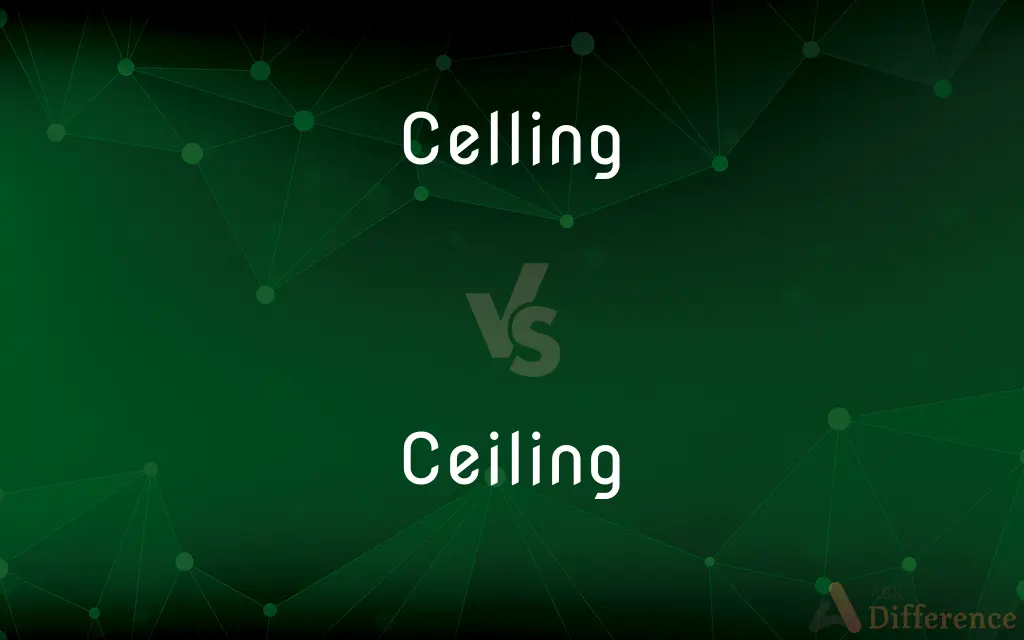Celling vs. Ceiling — What's the Difference?
By Fiza Rafique & Urooj Arif — Updated on March 16, 2024
"Celling" refers to the act of placing someone in a jail cell, while "ceiling" is the upper interior surface of a room.

Difference Between Celling and Ceiling
Table of Contents
ADVERTISEMENT
Key Differences
Celling is a verb that involves the action of confining someone in a jail cell or a similar enclosed space, typically as a form of detention or punishment. This term is associated with law enforcement and correctional facility practices. On the other hand, a ceiling is a noun that describes the top interior surface of a room or space, serving both functional and aesthetic purposes. It can be designed in various styles and is often used to hide electrical wiring or ventilation systems.
While celling is a specific action related to the criminal justice system, the concept of a ceiling is universal in architecture and interior design. Ceilings are an integral part of building construction, affecting the room's acoustics, temperature insulation, and overall ambiance. In contrast, celling represents a procedural outcome within the legal framework, emphasizing the physical and symbolic aspect of confinement.
The materials and construction techniques for ceilings vary widely, from simple plaster or drywall to elaborate decorative tiles or suspended panels. Ceilings can also feature lighting fixtures, decorative elements, and insulation materials to enhance a room's functionality and appearance. Conversely, celling is more about the administrative or legal action, with the physical attributes of the cell focusing on security and restraint rather than aesthetic or environmental considerations.
In terms of cultural and emotional impact, ceilings contribute to the perceived spaciousness and comfort of indoor environments. They can be crafted to reflect artistic visions or cultural themes, adding character and value to buildings. Celling, however, is associated with the deprivation of freedom and is often a subject of legal, ethical, and social debate, reflecting societal attitudes towards punishment and rehabilitation.
Despite their phonetic similarity, the terms operate in entirely different contexts—celling in the realm of law enforcement and criminal justice, and ceilings within the spheres of architecture, interior design, and everyday living spaces. Both terms, however, underscore the importance of context in understanding and applying language accurately.
ADVERTISEMENT
Comparison Chart
Definition
The act of placing someone in a cell.
The upper interior surface of a room.
Context
Law enforcement, correctional facilities.
Architecture, interior design.
Function
Confinement, detention.
Insulation, aesthetics, hiding installations.
Material/Technique
Security-focused design.
Plaster, wood, tiles, decorative elements.
Cultural/Emotional Impact
Associated with punishment.
Affects room ambiance and spaciousness.
Compare with Definitions
Celling
Placing or confining someone in a jail cell.
The suspect was celling after being arrested.
Ceiling
The top interior surface of a room.
The ceiling was painted with a stunning mural.
Celling
Involves aspects of security and control.
Modern jails have advanced celling technologies.
Ceiling
Part of architectural considerations.
High ceilings are a characteristic feature of Victorian homes.
Celling
Associated with the criminal justice system.
Celling is a step in the process following arrest.
Ceiling
Can be designed for sound insulation.
The studio's ceiling was acoustically treated to minimize noise.
Celling
Used metaphorically to describe isolation.
The artist felt celling in her creative block.
Ceiling
Features installations like lights.
The designer incorporated recessed lighting into the ceiling.
Celling
The process involved in detention.
Celling procedures require a strict adherence to legal standards.
Ceiling
Used to enhance room aesthetics.
Decorative beams were added to the ceiling for a rustic look.
Celling
A narrow confining room, as in a prison or convent.
Ceiling
A ceiling is an overhead interior surface that covers the upper limits of a room. It is not generally considered a structural element, but a finished surface concealing the underside of the roof structure or the floor of a story above.
Celling
A small enclosed cavity or space, such as a compartment in a honeycomb or within a plant ovary or an area bordered by veins in an insect's wing.
Ceiling
The upper interior surface of a room or other similar compartment
The books were stacked from floor to ceiling
Celling
(Biology) The smallest structural unit of an organism that is capable of independent functioning, consisting of cytoplasm, usually one nucleus, and various other organelles, all surrounded by a semipermeable cell membrane.
Ceiling
The inside planking of a ship's bottom and sides.
Celling
(Architecture) See web.
Ceiling
The upper interior surface of a room.
Celling
The smallest organizational unit of a clandestine group or movement, such as a banned political movement or a terrorist group. A cell's leader is often the only person who knows members of the organization outside the cell.
Ceiling
Material used to cover this surface.
Celling
A single unit for electrolysis or conversion of chemical into electric energy, usually consisting of a container with electrodes and an electrolyte; a battery. Also called electrochemical cell.
Ceiling
Something resembling a ceiling
A ceiling of leaves over the arbor.
Celling
A single unit that converts radiant energy into electric energy
A solar cell.
Ceiling
An upper limit, especially as set by regulation
Wage and price ceilings.
Celling
A fuel cell.
Ceiling
The highest altitude under particular weather conditions from which the ground is still visible.
Celling
A geographic area or zone surrounding a transmitter in a cellular telephone system.
Ceiling
The altitude of the lowest layer of clouds.
Celling
A cellphone.
Ceiling
The maximum altitude that an aircraft can reach under a given set of conditions, such as a minimum rate of climb.
Celling
(Computers) A basic unit of storage in a computer memory that can hold one unit of information, such as a character or word.
Ceiling
(Nautical) The planking applied to the interior framework of a ship.
Celling
A storm cell.
Ceiling
The overhead closure of a room.
The dining room had an ornate ceiling.
Celling
A small humble abode, such as a hermit's cave or hut.
Ceiling
The upper limit of an object or action.
Celling
A small religious house dependent on a larger one, such as a priory within an abbey.
Ceiling
(aviation) The highest altitude at which an aircraft can safely maintain flight.
Celling
A box or other unit on a spreadsheet or similar array at the intersection of a column and a row.
Ceiling
(meteorology) The measurement of visible distance from ground or sea level to an overcast cloud cover; under a clear sky, the ceiling measurement is identified as "unlimited."
Even though it was cloudy, there was still enough ceiling for the Blue Angels to perform a great show.
Celling
To store in a honeycomb.
Ceiling
(mathematics) The smallest integer greater than or equal to a given number.
The ceiling of 4.5 is 5; the ceiling of −4.5 is −4.
Celling
To live in or share a prison cell.
Ceiling
(nautical) The inner planking of a vessel.
Celling
(in combination) confinement in a cell
The prison was so crowded that they had to resort to double celling and then triple celling.
Ceiling
(finance) The maximum permitted level in a financial transaction.
Celling
Present participle of cell
Ceiling
(architecture) The overhead interior surface that covers the upper limits of a room.
Ceiling
The inside lining of a room overhead; the under side of the floor above; the upper surface opposite to the floor.
Ceiling
The inner planking of a vessel.
Ceiling
The overhead upper surface of a room;
He hated painting the ceiling
Ceiling
(meteorology) altitude of the lowest layer of clouds
Ceiling
An upper limit on what is allowed;
They established a cap for prices
Ceiling
Maximum altitude at which a plane can fly (under specified conditions)
Common Curiosities
Can the term "celling" be used outside of legal contexts?
While primarily used in legal contexts, "celling" can be metaphorically applied to describe situations of isolation or restriction.
What's the purpose of a ceiling in a room?
A ceiling serves several purposes including insulation, aesthetics, and concealing wiring or plumbing.
What does it mean to be "celling" someone?
To "cell" someone means to place them in a detention or jail cell, typically following an arrest or as part of a legal penalty.
How does ceiling design affect a room's appearance?
Ceiling design can significantly affect a room's appearance by influencing its perceived size, height, and overall ambiance through color, texture, and lighting.
What innovations are influencing modern ceiling designs?
Innovations in materials, lighting technology, and environmental sustainability are shaping modern ceiling designs, focusing on aesthetics, functionality, and eco-friendliness.
Can ceilings have health impacts?
Yes, ceilings can impact health through materials that affect indoor air quality or designs that influence lighting and acoustics, affecting well-being and comfort.
How is "celling" viewed from a human rights perspective?
From a human rights perspective, "celling" is scrutinized for its conditions, duration, and impact on detainees' rights and dignity.
Are there different types of ceilings?
Yes, there are various types of ceilings, such as flat, vaulted, cathedral, and drop ceilings, each offering different aesthetic and functional benefits.
What role do ceilings play in energy efficiency?
Ceilings contribute to energy efficiency by providing thermal insulation, reducing heat loss in winter and heat gain in summer, and can support energy-efficient lighting options.
Is "celling" a common term?
"Celling" is less common and more specialized, primarily used within the contexts of law enforcement and corrections.
Share Your Discovery

Previous Comparison
Seaweed vs. Nori
Next Comparison
Iliad vs. OdysseyAuthor Spotlight
Written by
Fiza RafiqueFiza Rafique is a skilled content writer at AskDifference.com, where she meticulously refines and enhances written pieces. Drawing from her vast editorial expertise, Fiza ensures clarity, accuracy, and precision in every article. Passionate about language, she continually seeks to elevate the quality of content for readers worldwide.
Co-written by
Urooj ArifUrooj is a skilled content writer at Ask Difference, known for her exceptional ability to simplify complex topics into engaging and informative content. With a passion for research and a flair for clear, concise writing, she consistently delivers articles that resonate with our diverse audience.














































